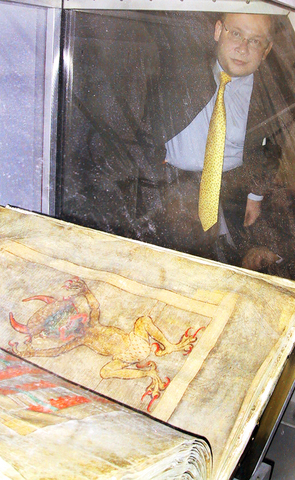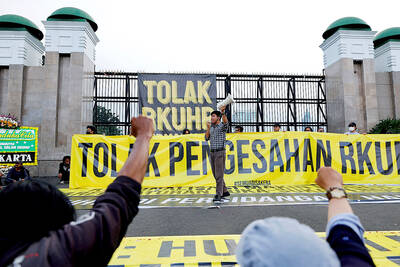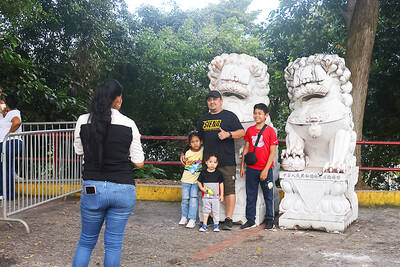The biggest medieval manuscript in the world, the Codex Gigas or Devil's Bible, should be exhibited again in Prague more than 350 years after it was carried off from the city as war booty by Swedish troops.
Created at the start of the 13th century, the parchment manuscript was considered at the time as the "the eighth wonder of the world," due to its impressive proportions (92cm x 50.5cm x 22cm), its 624 pages and weight of 75kg.
"Some 160 donkeys paid for its creation with their skin," explained Miroslava Hejnova, who is in charge of the historic and musical collection of the national library.

PHOTO: AFP
The Stockholm royal library has exceptionally agreed to loan the giant manuscript for an exhibition planned for the start of 2007 in part of the Clementium, the former Jesuit college built from 1653 to 1726 in the heart of ancient Prague.
Masterpiece
The masterpiece is the work of one monk alone, at the same time copier, illustrator and graphic designer, from the Podlazice monastery, in the center of the current Czech Republic. The monastery was destroyed in the religious wars of the 15th century.
The manuscript includes the old and new testaments, as well as historic texts such as the Chronica Boemorum, [Chronicle of the Czechs] written in Latin in the 12th century and the work of the historian Flavius Josephe [between the years 37-100].
According to legend, the creator of the Codex Gigas was condemned to be walled up alive for a serious crime. The manuscript was, it is said, the fruit of one single night's work aimed at atoning for the crime and creating something that would glorify the monastery forever. But to achieve such a feat, the monk had to get the devil's help. Once the masterpiece was complete, the monk slipped a portrait of his "helper" in the manuscript as recognition of the aid.
At the Stockholm royal library, visitors have the chance to see the 50cm-high illustration of the devil.
"To tell the truth, he seems to have a cute appearance, of someone in a very good mood," Heynova smiled.
In Prague, the manuscript, protected only by a wood cover, will be on show alongside other documents from the Middle Ages.
"It is sometimes disappointing when displaying a manuscript. In fact, you cannot let everyone finger through it, you have to select just two pages," said the director of the national library, Vlastimil Jezek, who hopes to attract at least 50,000 visitors for the exhibition.
Like many other priceless objects, the manuscript was taken as war booty at the end of the Thirty Years' War (1618-1648) by soldiers under Swedish general Koenigsmark from the famous Prague collection of the Hapsburg emperor and arts patron, Rudolf II (1552-1612).
"They took the most valuable objects of the collection," Hejnova said.
Soldiers also carried off the Codex Argenteus, written in silver and gold letters around 750 and today housed in Uppsala, central Sweden. Since the 17th century, the Codex Gigas has only left Sweden twice, to be exhibited at the Metropolitan Museum in New York in 1970 and in Berlin eight years ago.
Brief return
The brief return of the Codex Gigas to its country of origin was raised by Czech Prime Minister Jiri Paroubek during his visit to Sweden at the start of last month. He was careful to underline that the manuscript was being loaned and not returned.
At the start of the 1990s, former president Vaclav Havel attempted in vain to persuade Stockholm to return some objects historically linked with Bohemia, said the director of the national library.
And given that the request had no legal foundation, "if Vaclav Havel did not succeed then no one will succeed," admitted Jezek.

Shamans in Peru on Monday gathered for an annual New Year’s ritual where they made predictions for the year to come, including illness for US President Donald Trump and the downfall of Venezuelan President Nicolas Maduro. “The United States should prepare itself because Donald Trump will fall seriously ill,” Juan de Dios Garcia proclaimed as he gathered with other shamans on a beach in southern Lima, dressed in traditional Andean ponchos and headdresses, and sprinkling flowers on the sand. The shamans carried large posters of world leaders, over which they crossed swords and burned incense, some of which they stomped on. In this

Indonesia yesterday began enforcing its newly ratified penal code, replacing a Dutch-era criminal law that had governed the country for more than 80 years and marking a major shift in its legal landscape. Since proclaiming independence in 1945, the Southeast Asian country had continued to operate under a colonial framework widely criticized as outdated and misaligned with Indonesia’s social values. Efforts to revise the code stalled for decades as lawmakers debated how to balance human rights, religious norms and local traditions in the world’s most populous Muslim-majority nation. The 345-page Indonesian Penal Code, known as the KUHP, was passed in 2022. It

Near the entrance to the Panama Canal, a monument to China’s contributions to the interoceanic waterway was torn down on Saturday night by order of local authorities. The move comes as US President Donald Trump has made threats in the past few months to retake control of the canal, claiming Beijing has too much influence in its operations. In a surprising move that has been criticized by leaders in Panama and China, the mayor’s office of the locality of Arraijan ordered the demolition of the monument built in 2004 to symbolize friendship between the countries. The mayor’s office said in

‘TRUMP’S LONG GAME’: Minnesota Governor Tim Walz said that while fraud was a serious issue, the US president was politicizing it to defund programs for Minnesotans US President Donald Trump’s administration on Tuesday said it was auditing immigration cases involving US citizens of Somalian origin to detect fraud that could lead to denaturalization, or revocation of citizenship, while also announcing a freeze of childcare funds to Minnesota and demanding an audit of some daycare centers. “Under US law, if an individual procures citizenship on a fraudulent basis, that is grounds for denaturalization,” US Department of Homeland Security Assistant Secretary Tricia McLaughlin said in a statement. Denaturalization cases are rare and can take years. About 11 cases were pursued per year between 1990 and 2017, the Immigrant Legal Resource